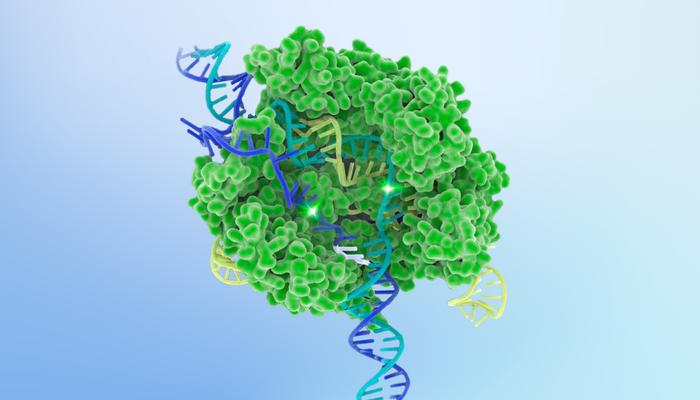

In a groundbreaking exploration of coronavirus-host interactions, researchers have unveiled the molecular underpinnings governing how the FCoV-23 virus engages with feline aminopeptidase N (FcAPN), an important receptor mediating viral entry. Utilizing state-of-the-art cryo-electron microscopy (cryo-EM), the crew resolved the construction of the FCoV-23 receptor-binding area (RBD) complexed with FcAPN at a powerful 2.5-angstrom decision, illuminating the intricate particulars of this viral handshake. This high-resolution map exposes a complicated community of interactions important for viral recognition and attachment, refining our understanding of receptor specificity amongst alphacoronaviruses.
The construction reveals that every protomer inside the FcAPN dimer accommodates one FCoV-23 RBD, establishing a bivalent mode of engagement that echoes binding paradigms noticed in associated alphacoronaviruses, corresponding to canine coronavirus (CCoV)-HuPn-2018 and porcine respiratory coronavirus (PRCV). Central to this interface are two receptor-binding loops on the viral spike protein, every orchestrating exact interactions with each the protein and glycan parts of FcAPN. In receptor-binding loop 1, the fragrant tyrosine residue at place 549 (Y549_FCoV-23) engages in CH–π interactions with the core fucose moiety of the N740 glycan on FcAPN. This interplay is additional stabilized by hydrogen bonding to important amino acids E735 and W741, establishing a glycan-mediated foothold that anchors the viral RBD.
Adjoining to this, the glutamine residue Q551_FCoV-23 varieties hydrogen bonds with the aspect chain of N740_FcAPN and intimately contacts the proximal N-acetyl-glucosamine and core fucose models of the glycan. These glycan-protein partnerships underscore the multifaceted nature of viral recognition, the place carbohydrate moieties on host receptors function important determinants of viral binding affinity and specificity. Receptor-binding loop 2 presents a complementary set of interactions: the cumbersome tryptophan residue W592_FCoV-23 nestles towards histidine (H790) and proline (P791) residues on FcAPN, whereas its imino group varieties a stabilizing hydrogen bond with the main-chain carbonyl of N787_FcAPN. Such detailed contacts spotlight the convergence of protein-protein and protein-glycan interactions in dictating viral tropism.
.adsslot_An35wbyYRW{ width:728px !necessary; top:90px !necessary; }
@media (max-width:1199px) { .adsslot_An35wbyYRW{ width:468px !necessary; top:60px !necessary; } }
@media (max-width:767px) { .adsslot_An35wbyYRW{ width:320px !necessary; top:50px !necessary; } }
ADVERTISEMENT
Apparently, a comparative evaluation with the associated CCoV-HuPn-2018 pressure reveals a important substitution at place 540 within the spike protein, the place an arginine residue (R540_CCoV-HuPn-2018) is changed by leucine (L546_FCoV-23) in FCoV-23. This mutation abolishes a salt bridge beforehand fashioned with glutamic acid (E786) on CfAPN, the canine receptor orthologue, comparable to glutamine 779 (Q779) in FcAPN. Such delicate but impactful amino acid modifications exhibit how variations in spike protein composition can modulate receptor engagement and species specificity.
Delving deeper into host receptor tropism, the examine highlights the pivotal function of an oligosaccharide at place N739 on human APN, a glycan notably absent on this orthologue however current in CfAPN, FcAPN, SsAPN (swine), and GgAPN (guinea pig). The absence of this glycan seems to underlie the shortcoming of FCoV-23 and related alphacoronaviruses like CCoV-HuPn-2018 and transmissible gastroenteritis virus (TGEV) to successfully bind human APN. By engineering a human APN mutant that reintroduces this glycan by way of the R741T substitution, the researchers rendered human cells permissive to viral entry mediated by the FCoV-23 spike protein, underscoring the glycan’s indispensability in receptor recognition.
Conversely, removing of the oligosaccharide from FcAPN—achieved by the T742R substitution—dramatically impaired viral entry by decreasing an infection effectivity by two orders of magnitude. This purposeful assay reinforces the structural observations, demonstrating that glycan-mediated interactions at this important web site will not be solely structurally important but in addition biologically consequential, influencing viral entry kinetics and tropism.
In an interesting twist, the crew noticed that entry mediated by the spike protein of the human coronavirus 229E (HCoV-229E) was environment friendly whatever the presence or absence of glycans at N739 (human APN) or N740 (FcAPN). This phenomenon correlates with earlier structural insights revealing that HCoV-229E targets an APN binding web site distinct from these exploited by FCoV-23, CCoV-HuPn-2018, and PRCV, reflecting divergent evolutionary methods amongst alphacoronaviruses for host receptor engagement.
Taken collectively, these findings illuminate the nuanced molecular dialogue between alphacoronaviruses and their cognate aminopeptidase N receptors, emphasizing the mixed significance of protein-protein and protein-glycan interactions in figuring out host vary and cross-species transmission potential. The revelation {that a} single glycan moiety can act as a molecular change governing viral entry highlights the beautiful specificity embedded inside these virus-host interfaces.
Furthermore, understanding how mutations inside the spike RBD affect the formation or disruption of salt bridges and hydrogen bonds supplies important insights into viral variations that will allow spillover occasions or alter viral infectivity. Such refinements in receptor engagement mechanics might function potential targets for antiviral methods aiming to disrupt viral attachment and entry.
The structural elucidation introduced on this examine was made attainable by advances in cryo-EM expertise, enabling researchers to seize intricate interplay particulars at near-atomic decision. This degree of element opens avenues for rational drug design and vaccine growth, providing templates for molecules that would competitively inhibit viral binding or masks important receptor epitopes.
Past receptor recognition, the implications of those discoveries prolong to viral entry kinetics and fusion effectivity. Notably, the lack of area 0 within the FCoV-23 spike protein was beforehand proven to boost fusogenicity, however its precise interaction with receptor binding remained unclear till now. The present analysis bridges this hole by correlating structural receptor engagement with purposeful fusion enhancement.
This complete understanding of how particular amino acid substitutions, glycosylation patterns, and receptor orthologue variability influence FCoV-23 infectivity enhances our predictive capabilities relating to coronavirus zoonosis. It additionally units the stage for broader comparative research throughout alphacoronaviruses, fostering preparedness towards emergent viral threats.
Because the world continues to grapple with coronavirus pandemics, these mechanistic insights underscore the significance of deciphering viral entry pathways at a molecular degree. Such information empowers the scientific group to anticipate viral evolution trajectories, design precision therapeutics, and probably thwart future outbreaks earlier than they manifest.
Topic of Analysis: Molecular mechanisms of FCoV-23 spike protein recognition and engagement with feline aminopeptidase N (FcAPN) and implications for coronavirus host specificity and viral entry kinetics.
Article Title: Lack of FCoV-23 spike area 0 enhances fusogenicity and entry kinetics.
Article References: Tortorici, M.A., Choi, A., Gibson, C.A. et al. Lack of FCoV-23 spike area 0 enhances fusogenicity and entry kinetics. Nature (2025). https://doi.org/10.1038/s41586-025-09155-z
Picture Credit: AI Generated
Tags: amino acid interactions in receptor bindingbivalent engagement in viral receptorscryo-electron microscopy viral structureFCoV-23 coronavirus receptor interactionsfeline aminopeptidase N bindingglycan-mediated viral attachmenthigh-resolution cryo-EM studiesmolecular interactions in viral recognitionreceptor specificity in coronavirusesreceptor-binding area complexstructural biology of FCoV-23viral entry mechanisms in alphacoronaviruses




